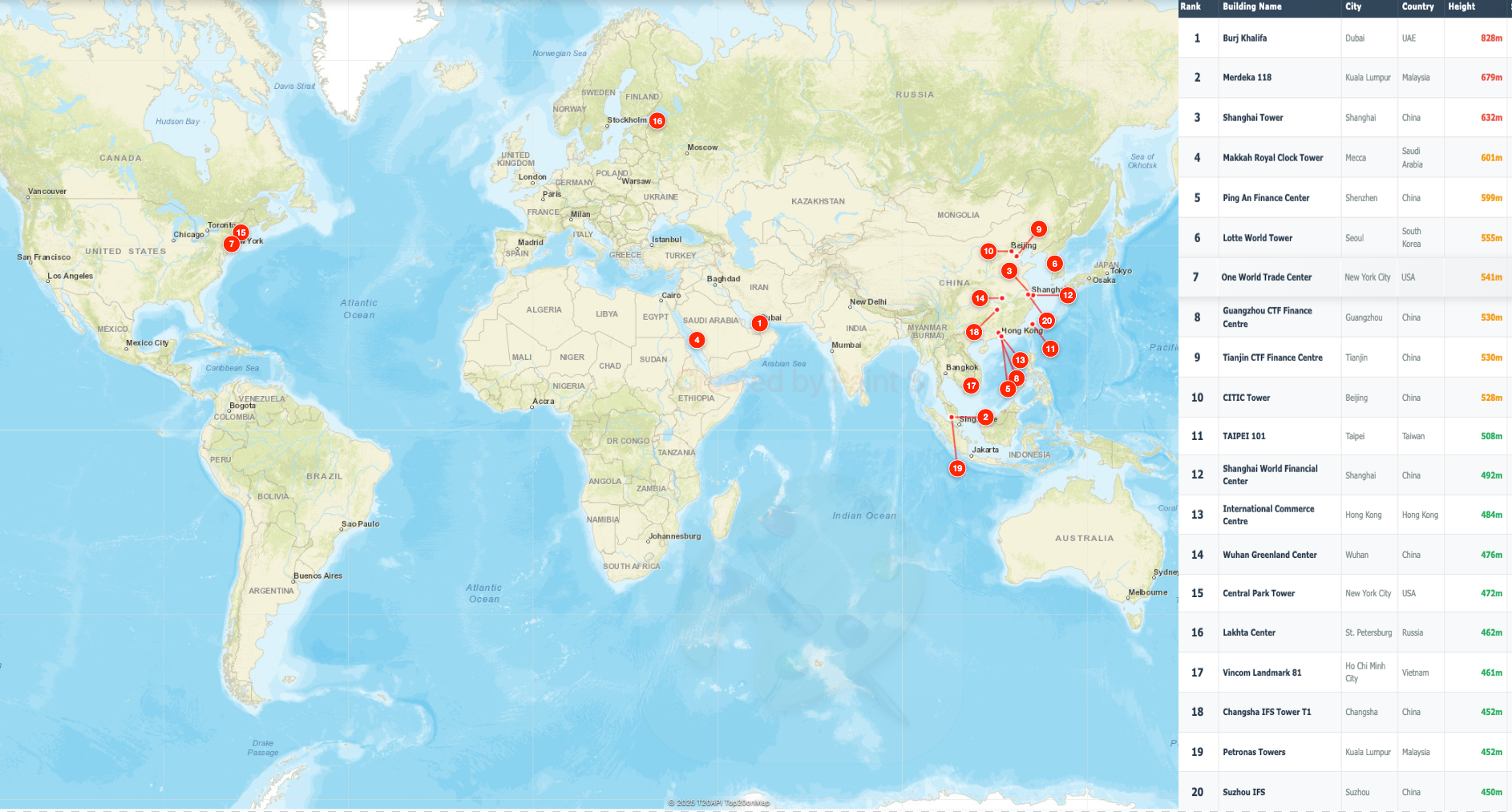Map of the World’s Tallest Skyscrapers


David Chen
Data Visualization Specialist
David Chen is an expert in transforming complex geographic datasets into compelling visual narratives. He combines his background in computer science ...
Geographic Analysis
What This Map Shows
This map visualizes the heights and locations of the world's tallest skyscrapers, specifically focusing on those that exceed 450 meters. A fascinating aspect to note is the dominance of structures in Asia and the Middle East, with only a handful of entries from other regions, including just two from the United States and one from Russia. The data for this visualization has been meticulously compiled from reputable sources such as the Council on Tall Buildings and Urban Habitat (CTBUH), ensuring accuracy in the architectural heights displayed.
Deep Dive into Skyscraper Heights
Skyscrapers have long been a symbol of urban ambition, architectural innovation, and economic prowess. The classification of a building as a skyscraper typically refers to structures that are at least 150 meters tall, but the elite club of buildings over 450 meters is a rarefied space. In fact, as of now, there are only a few skyscrapers globally that achieve this incredible height, reflecting not just engineering feats but also cultural and economic trends.
Interestingly, the highest building in the world, the Burj Khalifa in Dubai, stands at a staggering 828 meters. This iconic structure not only defines the Dubai skyline but also represents the Middle East’s rapid urbanization and economic growth in the 21st century. Following closely is the Shanghai Tower in China, which reaches 632 meters and showcases China's commitment to modern architecture and urban development.
When we delve deeper into the statistics, it becomes clear that Asia is the undisputed leader in skyscraper construction. Cities such as Shanghai, Hong Kong, and Dubai have transformed into hotbeds for architectural innovation, with numerous buildings surpassing the 450-meter threshold. For instance, the Ping An Finance Centre in Shenzhen, measuring 599 meters, illustrates China's relentless pursuit of height and modernity.
In contrast, the United States is represented by only two skyscrapers in this elite club: One World Trade Center in New York City, standing at 541 meters, and Central Park Tower, which reaches 472 meters. These buildings are not just architectural marvels; they also signify resilience and the rebirth of the skyline after the events of September 11, 2001.
Russia’s contribution to this elite list is the Lakhta Center in St. Petersburg, which at 462 meters, serves as a testament to the country's architectural ambitions and economic aspirations. It is intriguing to see how each of these skyscrapers not only reflects local architectural styles but also serves as a landmark that defines the cities in which they are located.
Regional Analysis
Breaking down the map by regions reveals intriguing disparities in architectural trends and urban development. In Asia, cities like Shenzhen and Shanghai are not just economic powerhouses but also cultural centers where modernity meets tradition. The skyline of Shanghai, for instance, features an amalgamation of historical architecture and futuristic designs, showcasing the city’s evolution over the years.
Meanwhile, the Middle East, particularly Dubai, has emerged as a global icon for luxury and innovation. The Burj Khalifa, alongside other monumental structures, attracts millions of visitors and serves as a hub for business and tourism. The architectural landscape here is characterized by extravagant designs and a focus on creating a unique urban experience.
In the United States, the presence of skyscrapers like One World Trade Center highlights the country’s resilience and adaptability. These structures not only serve practical purposes but also symbolize hope and renewal. Interestingly, New York's skyline, with its mix of historic and contemporary buildings, tells a story of a city that continuously reinvents itself while respecting its past.
Significance and Impact
Understanding the distribution and significance of the tallest skyscrapers is crucial for grasping broader trends in urbanization and economic development. As cities grow and populations increase, skyscrapers often become necessary to maximize space and resources. They symbolize economic strength and cultural identity, reflecting the aspirations of the societies that build them.
Moreover, the trend of constructing taller skyscrapers is also indicative of advancements in engineering and architectural design. As technology evolves, so too does the ability to build structures that were once thought impossible. However, this also raises questions about sustainability and urban planning. As cities expand vertically, there is a growing need to consider the environmental impact and the infrastructure necessary to support such growth.
In conclusion, the world’s tallest skyscrapers are more than just stunning architectural achievements; they embody the ambitions and innovations of the regions they inhabit. As we look to the future, the ongoing evolution of urban landscapes will undoubtedly continue to challenge our perceptions of space, design, and sustainability in an ever-changing world.
Visualization Details
- Published
- September 26, 2025
- Views
- 58
Comments
Loading comments...